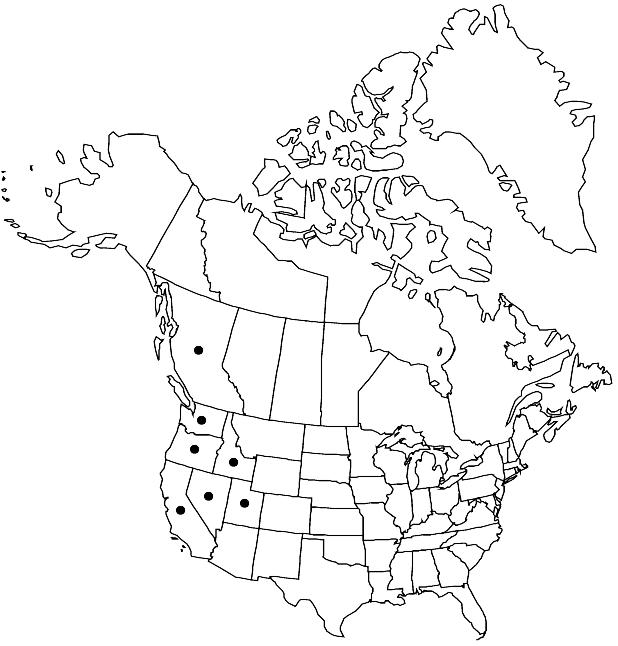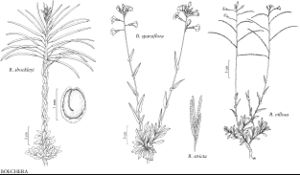Boechera sparsiflora
Vasc. Pl. Wyoming ed. 3, 376. 2001.
Biennials or perennials; short-lived; sexual; caudex present or absent. Stems usually 1 per caudex branch, arising from center of rosette near ground surface, 3–8 dm, densely pubescent proximally, trichomes simple mixed with fewer short-stalked, 2-rayed ones, 0.4–1.5 mm, glabrous or sparsely pubescent distally. Basal leaves: blade oblanceolate or linear-oblanceolate, 3–12 mm wide, margins usually entire, rarely dentate, ciliate proximally, trichomes (usually simple), to 1 mm, surfaces densely pubescent, trichomes short-stalked, 2–5-rayed, 0.3–0.8 mm. Cauline leaves: (9–)15–35, often concealing stem proximally; blade auricles 3–10 mm, surfaces of distalmost leaves glabrous, sometimes margins ciliate. Racemes 12–50-flowered, usually unbranched. Fruiting pedicels usually ascending, rarely almost horizontal, straight or slightly recurved, 3–10(–18) mm, usually pubescent, rarely glabrous, trichomes spreading, usually simple. Flowers ascending at anthesis; sepals sparsely pubescent; petals usually lavender to purple, rarely white, 7–13 × 2–5 mm, glabrous; pollen ellipsoid. Fruits usually ascending, rarely almost horizontal, not appressed to rachis, not secund, usually curved, edges parallel, 5–13 cm × 1.7–2 mm; valves glabrous; ovules 90–170 per ovary; style 0.05–0.3 mm. Seeds uniseriate, 1.5–2 × 1–1.5 mm; wing continuous, 0.1–0.2 mm wide. 2n = 14.
Phenology: Flowering Apr–Jun.
Habitat: Rocky slopes, clay hills, sandy soil in sagebrush and mountain shrub communities, meadows, and open conifer forests
Elevation: 400-2800 m
Distribution

B.C., Calif., Idaho, Nev., Oreg., Utah, Wash.
Discussion
As circumscribed by R. C. Rollins (1993), Boechera sparsiflora included six varieties encompassing three sexual diploids and a number of apomictic hybrids. The most distinctive of those elements are recognized here as the separate species B. arcuata, B. atrorubens, B. californica, and B. pauciflora. The narrow circumscription of B. sparsiflora adopted here includes only sexual diploids. It is distinguished from other taxa previously assigned to it by having proximal stems densely pubescent with predominantly simple (some 2-rayed) trichomes to 1.5 mm, usually glabrous distal stems, and ascending fruiting pedicels with spreading, usually simple trichomes (rarely glabrous).
Selected References
None.
